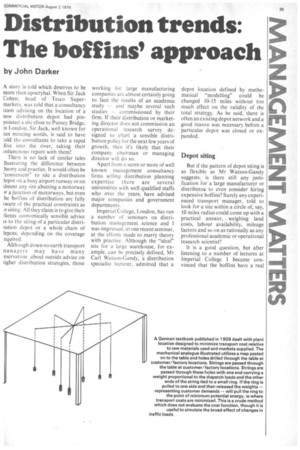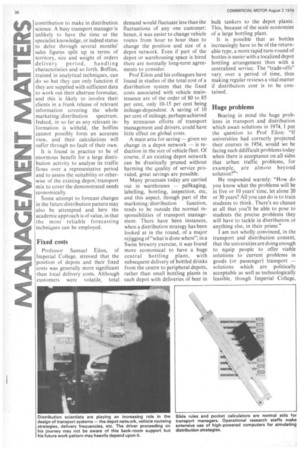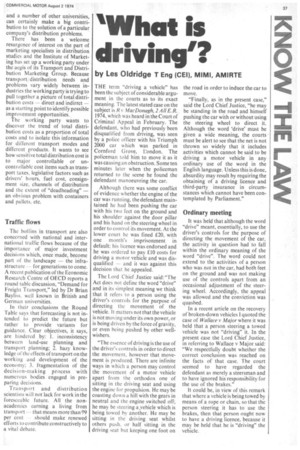Distribution trends: The boffins' approach
Page 37

Page 38

Page 39

If you've noticed an error in this article please click here to report it so we can fix it.
by John Darker
A story is told which deserves to be more than apocryhal. When Sir Jack Cohen, head of Tesco Supermarkets, was told that a consultancy Learn advising on the location of a new distribution depot had pinpointed a site close to Putney Bridge, in London, Sir Jack, well known for not mincing words, is said to have told the consultants to -take a rapid Jive into the river, taking their voluminous report with them!
There is no lack of similar tales .11ustrating the difference between :heory and practice. It would often be 'convenient" to site a distribution Jepot on a busy airport runway or on ilmost any site abutting a motorway )1a junction of motorways, but even he boffins of distribution are fully iware of the practical constraints as o siting. All they claim is to give their lients economically sensible advice LS to the siting of a particular distrimtion depot or a whole chain of lepots, depending on the coverage 'equired.
Although down-to-earth transport nanagers may have many .eservation about outside advice on tigher distribution strategies, those working for large manufacturing companies are almost certainly going to face the results of an academic study — and maybe several such studies — commissioned by their firm. If their distribution or marketing director does not commission an operational research survey designed to chart a sensible distribution policy for the next few years of growth, then it's likely that their company chairman or managing director will do so.
Apart from a score or more of well known management consultancy firms selling distribution planning expertise there are several universities with well qualified staffs who over the years, have advised major companies and government departments.
. Imperial College, London, has run a number of seminars on distribution management science and was impressed, at one recent seminar, at the efforts made to marry theory with practice. Although the "ideal" site for a large warehouse, for example, can be precisely defined, Mr Carl Watson-Gandy, a distribution specialist lecturer, admitted that a depot location defined by mathematical "modelling" could be changed 10-15 miles without too much effect on the validity of the total strategy. As he said, there is often an existing depot network and a good reason was necessary before a particular depot was closed or expanded.
Depot siting But if the pattern of depot siting is as flexible as Mr Watson-Gandy suggests, is there still any justification for a large manufacturer or distributoD to even consider hiring expensive boffins? Surely any experienced transport manager, told to look for a site within a circle of, say, 10 miles radius could come up with a practical answer, weighing land costs, labour availability, mileage factors and so on as rationally as any professional academic or operational research scientist?
It is a good question, but after listening to a number of lectures at Imperial College I became convinced that the boffins have a real contribution to make in distribution science. A busy transport manager is unlikely to have the time or the specialist knowledge, or indeed status to delve through several months' sales figures split up in terms of territory, size and weight of orders delivery period, handling characteristics and so forth. Boffins, trained in analytical techniques, can do so but they can only function if they are supplied with sufficient data to work out their abstruse formulae, and this is likely to involve their clients in a frank release of relevant information covering the whole marketing / distribution spectrum. Indeed, in so far as any relevant information is witheld, the boffins cannot possibly form an accurate view, and their calculations will suffer through no fault of their own.
It is found in practice to be of enormous benefit for a large distribution activity to analyse its traffic flows over a representative period and to assess the suitability or otherwise of the existing depot/transport mix to cover the demonstrated needs economically.
Some attempt to forecast changes in the future distribution pattern may also be attempted and here the academic approach is of value, in that the most reliable forecasting techniques can be employed.
Fixed costs
Professor Samuel Eilon, of Imperial College, stressed that the position of depots and their fixed costs was generally more significant than local delivery costs. Although customers were volatile, total. demand would fluctuate less than the fluctuations of any one customer; hence, it was easier to change vehicle routes from hour to hour than to change the position and size of a depot network. Even if part of the depot or warehousing space is hired there are normally long-term agreements to consider.
Prof Eilon and his colleagues have found in studies of the total cost of a distribution system that the fixed costs associated with vehicle maintenance are of the order of 80 to 85 per cent, only 10-15 per cent being mileage-dependent. A saving of 10 per cent of mileage, perhaps achieved by strenuous efforts of transport management and drivers, could have little effect on global costs.
A main area for saving — given no change in a depot network — is reduction in the size of vehicle fleet. Of course, if an existing depot network can be drastically pruned without harming the quality of service provided, great savings are possible.
Many processes today are carried out in warehouses — pa9kaging, labelling, bottling, inspection, etc, and this aspect, though part of the marketing/distribution function, tends to be outside the normal responsibilities of transport management. There have been instances, when a distribution strategy has been looked at in the round, of a major rejigging of "what is done where"; in a Swiss brewery exercise, it was found more economical to have a huge central bottling plant, with subsequent delivery of bottled drinks from the centre to peripheral depots, rather than small bottling plants in each depot with deliveries of beer in bulk tankers to the depot plants. This, because of the scale economies of a large bottling plant.
It is possible that as bottles increasingly have to be of the returnable type, a more rapid turn-round of bottles is easier with a localized depot bottling arrangement than with a centralized service. The "trade-offs" vary over a period of time, thus making regular reviews a vital matter if distribution cost is to be contained.
Huge problems
Bearing in mind the huge problems in transport and distribution which await solutions in 1974, I put the question to Prof Eilon: "If universities had correctly projected their courses in 1954, would we be facing such ddifficult problems today when there is acceptance on all sides that urban traffic problems, for example, are almost beyond solution?'
He responded warmly: "How do you know what the problems will be in five or 10 years' time, let alone 20 or 30 years? All you can do is to train students to think. There's no chance at all that you'll be able to pose to students the precise problems they will have to tackle in distribution or anything else, in their prime."
I am not wholly convinced, in the transport and distribution context, that the universities are doing enough to equip people to offer viable solutions to current problems in goods (or passenger) transport — solutions which are politically acceptable as well as technologically feasible, though Imperial College, and a number of other universities, can certainly make a big contribution to the solution of a particular company's distribution problems.
There has been a welcome resurgence of interest on the part of marketing specialists in distribution studies and the Institute of Marketing has set up a working party under the aegis of its Transport and Distribution Marketing Group. Because transport/ distribution needs and problems vary widely between industries the working party is trying to pull together a picture of total distribution costs — direct and indirrct — as a starting point to identify possible improvement opportunities.
The working party wants to discover the trend of total distribution costs as a proportion of total costs and to isolate this information for different transport modes and different products. It wants to see how sensitive total distribution cost is to major controllable or uncontrollable cost items such as transport taxes, legislative factors such as drivers' hours, fuel cost, consignment size, channels of distribution and the extent of "deadheading" — an obvious problem with containers and pallets, etc.
Traffic flows
The boffins in transport are also concerned with national and international traffic flows because of the importance of major investment decisions which, once made, become part of the landscape — the infrastructure for generations to come. A recent publication of the Economic Research Centre of OECD reports a round table discussion, "Demand for Freight Transport," led by Dr Brian Bayliss. well known in British and German universities.
In their conclusions the Round Table says that forecasting is not intended to predict the future but rather to provide variants for guidance. Clear objectives, it says, are hindered by: I. inconsistency between land-use planning and transport planning; 2. hazy knowledge of the effects of transport on the working and development of the economy; 3. fragmentation of the decision-making process with numerous bodies engaged in preparing decisions.
Transport and distribution scientists will not lack for work in the foreseeable future. All the nonacademics earning a living from transport that Means more than 99 per cent should make renewed efforts to contribute constructively to a vital debate.




























































































